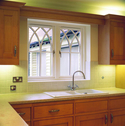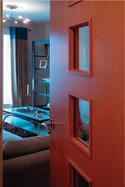Joiners keep watching brief on uncertain economy
19 January 2008Business is steady in the joinery sector although companies are well aware of the delicate balance of the economy
Summary
• Many joiners are satisfied with orders.
• Joiners at the higher-quality end of the market are most upbeat.
• Cost pressures are being felt more keenly by mass producers.
• The BWF is urging members to be vigilant over costs and credit control.
• BFRC ratings are said to be gaining more credibility in the market.
The joinery market appears delicately poised, especially for those firms operating in price-sensitive areas of the trade. While many companies report adequate workloads, everyone is conscious of the confidence-sapping economic indicators besieging UK industry.
Specifically, there has been evidence of a reduction in new housing transactions, allied to concerns that increased newbuild figures in the public sector will not compensate for any significant slowdown in the private sector. But despite these considerations and concern that the “credit crunch” may affect commercial and other markets, many joiners appear satisfied with their own business volumes. “Joiners are aware of the negative indicators and are finding it competitive, but the work has been there,” TTJ was told.
However, with further increases anticipated in timber and energy costs, many joinery firms face a struggle to maintain their margins.
A spokesperson for a company which enjoyed a successful 2007 and a healthy start to 2008 captured the tone of the market in saying: “We are comfortable at the moment – and I stress ‘at the moment’. Everything we hear seems to say things are going to go backwards.” Another contact summarised the market: “There is certainly no sense of despair but, similarly, there is no great expectation of a major improvement.”
Upbeat at the higher end
Joinery companies working at the higher-quality end of the domestic and commercial markets appear to be the most upbeat as their customers are generally prepared to pay more. As a result, joinery firms have been able to ask higher prices and go some of the way towards recouping the higher costs. One architectural joiner estimated that labour, energy and material costs had risen by an average of 10% last year but that his company had maintained its margins. “We have not been shy to ask for the right amount of money for the job,” he said. Nevertheless, he added, the company’s order file going into 2008 was on a par with that of early 2007, with the top-end commercial and retail sectors seemingly offering the most promise.
A door and window manufacturer expressed similar sentiments: demand from the higher-quality end of the market had been more robust. A contact estimated that combined costs – including energy, timber, glass and metalware – had risen around 7% last year. While it had been impossible to pass on all of these costs to customers, the shortfall had been covered by improved efficiencies. He also pointed to an upturn in competition from eastern Europe, notably on windows.
A mass producer reported a pick-up in demand for timber windows and stairs in the final quarter of last year, although the door market remained relatively flat. Having declined to increase its timber window prices in 2007, the company plans to raise its prices by around 5% towards the end of the first quarter of 2008. Door prices rose by 4-5% at the start of 2008, the company confirmed.
Clearly, cost pressures are being felt more keenly at the more cost-conscious, volume-led end of the market where customers are either postponing expenditure or are taking advantage of a competitive market place to drive down supplier prices wherever possible.
Cost vigilance
Against this backdrop, the British Woodworking Federation (BWF) has urged joinery companies to be ever more vigilant over costs and credit control. It has reiterated its warning that late payments and non-payment by customers represent major triggers for crisis, particularly among smaller businesses. The BWF said there was a slight increase in the number of its members leaving the industry last year. Noting that the organisation lost more than 2% of its core manufacturing membership for the third year in succession, a spokesperson added that a significant proportion of these firms had fallen victim to problems associated with bad debts.
The BWF also acknowledged that many joinery firms had opted to mitigate the impact of energy price spikes by entering into longer-term purchasing contracts. It urged companies to continue to monitor the energy market to ensure they secured the best rate.
Meanwhile, joiners continue to report significantly more interest in sustainability issues, with demands for FSC- and PEFC-certified timber becoming more common. “Customers appear much more prepared to consider more expensive products if they are environmentally sound – although only up to a point,” TTJ was told. The problem, according to one contact, is that demand for certified timber is often at odds with the trend towards customers “wanting something different”.
Window energy rating
Also on the environmental theme, the British Fenestration Rating Council (BFRC) window energy rating system has seen a huge increase in the number of windows being rated. More than 100 companies have had products rated, with well over 80% thought to fall into categories A, B or C. Most are PVCu-framed, but more timber window makers are now going for a rating.
According to joiners, BFRC ratings are gaining greater credibility in the market place and are being mentioned increasingly in specifiers’ documentation. However, The Gl@zine newsletter reported recently that the number of energy-efficient window types registered by rating band remains just a fraction of the total on the market. In fact, it is estimated that A-, B- and C-rated windows combined still make up less than 3% of installations. And although the technology exists for A-band windows, there isn’t industry capacity to produce 100% of windows as even C band – “let alone more demanding specifications”.
It is understood that discussions are taking place with a view to increasing the label fee associated with the BFRC rating scheme. The additional revenue could be used to fund a consumer marketing campaign that would reinforce the benefits of rated windows.
Window alliance
Meanwhile, driving forces behind the Wood Window Alliance (WWA) are looking to maintain the momentum established following its launch in September at the 100% Detail architectural exhibition in London. Targets include developing alliance membership along the whole of the supply and manufacturing chain, as well as the creation of “support packages” for members to use in their own marketing.
According to the BWF, there has been a steady increase in demand for life cycle assessment data for wood windows. The Federation has been working with the BRE and is hopeful that data will be available later this year. Also, the BWF plans to “reinvigorate” its fire doors campaign, focusing not only on the benefits of well-manufactured fire doors but also on the dangers inherent in not using certified products.
This year will also bring a new phase for the BWF’s Code of Conduct. By the end of 2007, all federation members had received at least one assessment visit; the focus will now shift to assessing how companies have progressed and how they can be helped to move forward in terms of good practice.
Chiltern Dynamics reports healthy demand for security testing for doors and windows, but has also warned companies to keep standards under review “as intruders become more resourceful”.

